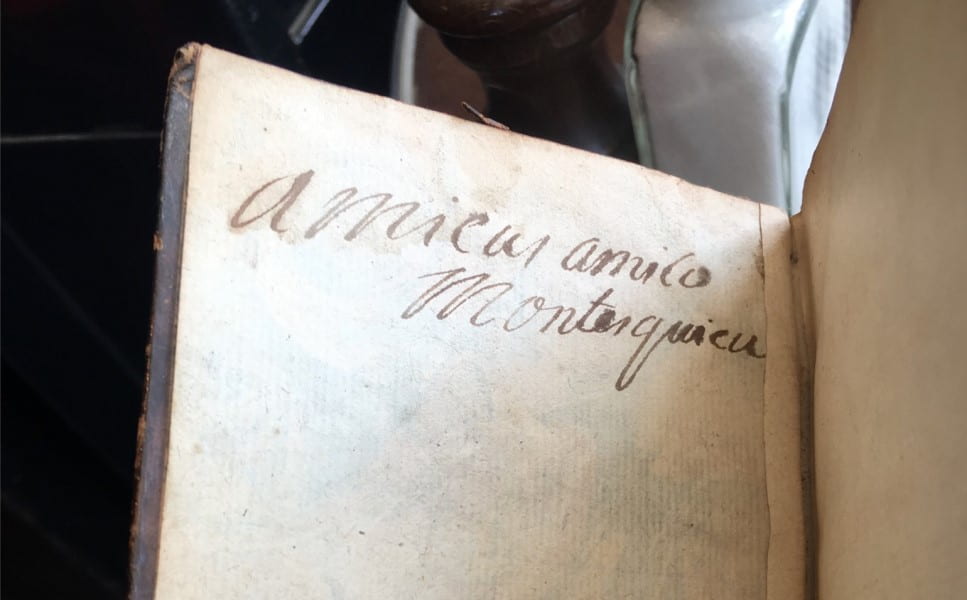By Benjamin Bernard
Out of the many changes in French society over the course of the eighteenth century that made the Revolution possible, the ideas of celebrated writers known as philosophes remain an important part of the story. Revolutionaries looked back to the likes of Voltaire, Rousseau, Diderot, and Montesquieu either to define political aims or to justify their actions post hoc. While most historians would not claim that the course of the French Revolution directly resulted from the ideas of celebrity-philosophers alone, the relationship between reading and revolution has for generations offered one of the most fertile, yet also most contested, topics of study for eighteenth-century scholars. As Yale literary historian Henri Peyre said about the French Revolution in the Journal of the History of Ideas in 1949, “No question is likely to divide students of the past more sharply than that of the action of philosophical ideas and literary works upon political and social events.” Today, some subfields in eighteenth-century studies are still shaped by this question. For revolutionaries in the 1780s and 1790s to have found inspiration in these books, it is worth asking what made such works so popular when they were first published. Why did readers take so quickly to the ideas of the philosophes in the generation active from 1740–1770?
This blogpost provides one answer by focusing on a remarkable primary source I came across during my dissertation research: a single manuscript letter from 1749 that illustrates the social and material circuitry underlying the spread of Enlightenment ideas (Fig. 1). This letter was written to an aspirational young Parisian bourgeois, Pierre-Michel Hennin, who organized a literary circle with his former schoolmates in the late 1740s. The group included the letter’s author, a future lawyer named Claude-Rigobert Lefebvre de Beauvray. After graduating from a collège, or Latin grammar school, in the Latin quarter and moving into law studies, they participated in a salon-like society that even had a special nickname: the Morosophes. As their careers began to carry them around Europe, they stopped meeting in person—and instead, in their early- to mid-twenties, maintained a regular correspondence together about the books they read, the theater and opera they attended, and gossip about their friends, about court life, and about the women they encountered at salons and in the theater. Rather than a formal learned society in the Republic of Letters, they did not strive so much to advance human knowledge as much as to be entertained, titillated, and up-to-date in a fast-paced information world in which news increasingly spread not only orally and in manuscript but now also in cheap pamphlet form. In excited tones, they shared with each other the latest novelties as quickly as they could. Whereas Renaissance humanists scribbled marginal annotations, these Enlightenment readers wrote letters.

In December 1748, the group first got wind of a new forbidden book: “They’re also clandestinely selling a new work, by Mr. Secondat de Montesquieu, of which I don’t know the title,” wrote Lefebvre de Beauvray to his friend Hennin. They were already familiar with his Lettres Persanes (1721) which, despite appearing before they were born, remained popular. Yet it was not until the spring that Lefebvre de Beauvray finally got his hands on the new text: On the Spirit of the Laws (Fig. 2). Their correspondence confirms that Enlightenment-era readers knew that Montesquieu was the author, even though he published the text anonymously and clandestinely in Geneva.
Well, the young man was so enthralled that on March 16, 1749, he penned a 4,700-word letter in tight scrawl over seven pages to Hennin and their friends summarizing and commenting on the book. This rich document, part of the Hennin papers held by the library of the Institut de France (Fig. 1), reveals many aspects of Enlightenment intellectual sociability.
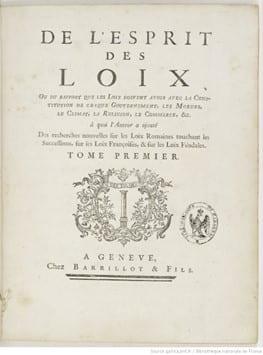
In others of their letters, these friends exchanged poems, jokes, and scandalous stories about urban life; but Lefebvre de Beauvray began by explaining to Hennin that this letter will focus on more elevated matters, “the highest policy matters, and Reason” rather than lighter fare. “But it is precisely because I truly esteem him highly,” Lefebvre de Beauvray clarified, “that I dare to find some flaws in his work…” While the letter includes many threads, including Lefebvre de Beauvray’s deep skepticism of institutionalized Christian doctrine, two areas that drew his attention that I will focus on were constitutional forms of government and sexual politics.
First, his politics. Lefebvre de Beauvray did not read Montesquieu in a republican idiom. In fact, he pushed back against Montesquieu’s valorization of republics. In Book 8 chapters 16 and 17, Montesquieu offers characteristics of republics and monarchies respectively, and suggests that a “monarchy is a [form of] government whose spirit is more turned towards aggrandizement.” Lefebvre de Beauvray allowed that monarchies do have downsides: the danger of devolution of power in the provinces to nobles, for instance, which could foment the spirit of revolution—a form of which would begin to occur in the colonies of British North America. But he also challenged Montesquieu’s rosy view of republics, for they too could become just as decadent, with laws and economic structures as out of step with the mores of a particular nation as a despotic monarch. He asked his friend to remember that strongmen can acquire power in republics: Hannibal, Marius, Scylla, Caesar, and so many others. At least in this first encounter with the text, he was skeptical of the more overtly republican implications of the book even as he admired Montesquieu’s thinly veiled account of the government of England.
So, Lefebvre de Beauvray read Montesquieu as a monarchist, not as a republican—and certainly not as any kind of revolutionary. They were hardly going to read one clandestine book and jump to the barricades. This fact makes a great deal of sense when we think about the trajectories he and his friends followed as they climbed through Old Regime society, gaining social mobility through service to the absolutist state and to aristocratic patrons. Indeed, Pierre-Michel Hennin would himself become one of the very last men ennobled under the Old Regime: he gained an aristocratic title in 1788 and served as the secretary of the Assembly of Notables on the eve of the Revolution. In the time when Montesquieu’s monumental intellectual work was published, readers like Lefebvre de Beauvray did not expect its ideas to find concrete political expression in French and American revolutions; many more steps would be necessary over the coming decades for the texts to contribute to such efforts.
Yet history has also proven Lefebvre de Beauvray partly right. The examples of Carthaginian, Roman, and Venetian strongmen had illustrated for him that republics do not solve all the problems of monarchies. One day, after Lefebvre de Beavray had become old, blind, and infirm, Napoleon (born in 1769) would coopt a republic revolution in France to crown himself emperor.
Second, Lefebvre de Beauvray put gender politics and sexual titillation front and center, and not only to criticize Montesquieu. He singled out for admiration for Book 30 Chapter 32, which contains Montesquieu’s gloss on “our supposed Salic Law,” the custom by which the French throne could only be inherited through the male line. Montesquieu explained that royal women’s exclusion was a norm inherited from feudalism that predated the modern monarchy; this explanation for the misogyny of French custom was sufficient to satisfy Lefebvre de Beauvray. But Lefebvre de Beauvray also challenged Montesquieu by proposing an alternate, natural law-based explanation (frankly, it’s an over-simplified, unconvincing one) for the origins of the taboo prohibition on consanguineal marriage.
Not only was he drawn to the masculinist gender analysis of Montesquieu’s political thought, but Lefebvre de Beauvray also interspersed his discussion of constitutional ideas with impish rhymes about sex with women. He was performatively self-conscious of lingering too long on matters of political philosophy and so, “To compensate for the seriousness of this letter, and to conclude it with something gay and entertaining,” he ended the letter with a comment on another of his new favorite books from that year: the clandestine libertine pornographic bestseller Thérèse Philosophe (which historian of France Robert Darnton partially translated into English a generation ago) (Fig. 3.1 and 3.2). Instead of an argumentative response, he penned a rhyming epigram:
“In her apartment furtively,
[“Anne en son appartement
Anne read so attentively,
Thérèse Philosophe,
And with her hand, doth
‘hemmed her cloth;’
That is, she took up thereupon
To imitate the mad Onan…
‘Well, well!’ Damis to the beauty cried—
she hadn’t noticed he had spied—
‘What thinkest you of this great book?’
‘Me?’ she replied with a naughty look:
‘As for this novel aforesaid,
I find that it must be read
With just one hand, my legs a-spread.’”
Lisoit attentivement
Thérèse Philosophe,
Et d’une main cependant
La belle ourloit son étoffe,
Id est, imitoit Onan…
Eh bien! Demande à la Belle
Damis en la suprénant,
Au fond de ce beau Roman,
que pensés vous? Moi! dit-elle
Avec un souris malin;
Qui sembloit beaucoup plus dire,
je trouve, qu’on ne peut le lire,
Comme il faut, que d’une main.”]
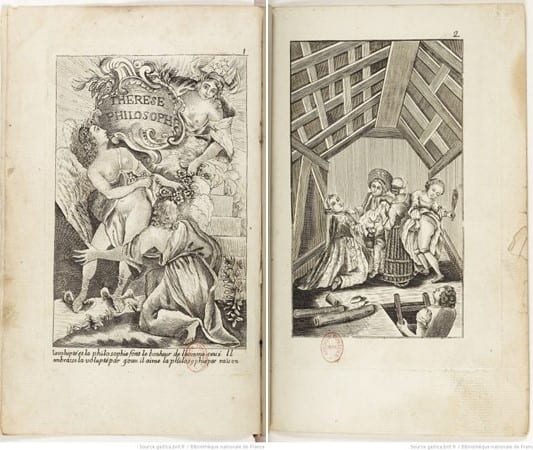
This bawdy register was totally characteristic of these adolescent friends. In another of his letters he circulated to his friends an erotic auto-fictional epigram several pages long that narrated one of his wet dreams. There might seem to be no stranger pairing than On the Spirit of the Laws, which would inspire America’s founders, with Thérèse Philosophe, which inspired so many eighteenth-century masturbators. Yet as I peer over Lefebvre de Beauvray’s shoulder while he read his way through the Enlightenment, what I see is that he himself associated them together as common pieces of his cultural world—one centered on his group of friends. These young men would not have engaged so deeply with Montesquieu’s ideas had they not already institutionalized an epistolary circle propped up by pornography and by gossip—gossip about the women they met in salons and the actresses they found fetching. Para-intellectual, witty banter was a social practice, one that bound young men together in sentimental friendship to the exclusion of women—precisely the kind of fraternité that revolutionaries would soon enshrine in their tripartite slogan.
The dual values of this group—learning and whimsy, prose and poetry, politics and pornography, male friendship, and misogyny—explains perhaps why Lefebvre de Beauvray, Hennin, and their friends called the literary society they had once participated in together “les Morosophes”— “wise fools” or “foolosophers,” a word employed to satirical ends by Erasmus and Rabelais. The same Greek roots make up the word “sophomore” today.
It is quite possible that Montesquieu’s own social relations read his book similarly. My personal copy of Montesquieu’s earlier Considérations des causes de la grandeur des romains et de leur décadence (1734; 1748), snagged at a French flea market, appears to bear the author’s signature and inscription—appropriately, in Latin—to an anonymous friend (featured image). The artifact suggests that Enlightenment readers not only felt a fictive proximity to philosophes by virtue of their mediatized celebrity, as historian Antoine Lilti has written, but that many enjoyed the company of philosophes by virtue of their own cosmopolitanism. Indeed, Lefebvre, Hennin, and their friends became quite friendly with Voltaire, and all the more so when Hennin became Louis XV’s ambassador to Geneva and Voltaire settled down the road at Ferney. In their epistolary exchanges, Voltaire signed some of his letters to Hennin with the tongue-in-cheek epithet, “Le Solitaire” [the Solitary One]. This image is misleading in that it expresses precisely the opposite of why Enlightenment readers such as Lefebvre de Beauvray found new works so exciting: because they could be shared together.
In another sense, though, Voltaire’s ironic epithet also captures a deeper truth about the spirit of the Enlightenment. They were the first generation to pass through rhetoric classes after the Quarrel of Ancients and Moderns had wracked the Francophone world of letters and had never revered authors of antiquity unconditionally. At one point in this letter about Montesquieu, Lefebvre de Beauvray inserted a quatrain of his own composition and then commented to his friend Hennin (and whoever else in their circle might read the letter):
“Tell me, does it not seem strange to you to see an author cite himself? What would you have me do? Everyone has their own form of madness: that of many people is to cite the Ancients, as much as the moderns; tam veteres, quam recentiores. As for me, mine is to cite myself.”
With a sense of play and a bourgeois education, Lefebvre de Beauvray expressed the radical individualism of a modern age. In this way, his animated correspondence provides a window onto the material history of sociable reading during the Enlightenment.
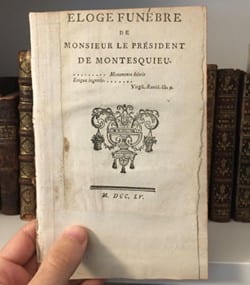
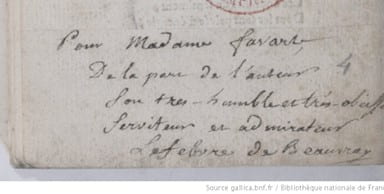
It also helps explain why, in 1755, Lefebvre de Beauvray wrote and published a funeral elegy praising Montesquieu (Fig. 4.1 and 4.2). Like any good poem in this genre the language is somewhat overblown (“Thus from Montesquieu’s creativity/ The laws of nations finding symmetry…”). Compared with the manuscript from seven years earlier, Lefebvre de Beauvray’s interpretation of and esteem for On the Spirit of the Laws remained mostly consistent. In the funeral poem, Lefebvre de Beauvray emphasized the bold implications of the work:
“Revolt raises its standard everywhere:
[“La révolte par-tout lève ses étendards :
A thousand arrows fly here and there:
Of image and icon, of god and of king,
Nothing is sacred or safe from his sting.”
Mille traits, mille feux, volent de toutes parts :
De ses rois, de ses dieux, séjour, autel, image,
Rien n’est sacré pour lui dans l’excès de sa rage…”]
True, he may not have had the Bourbon dynasty in mind. Nevertheless, perhaps it took the deaths of the philosophes for French readers to zero in on the more radical potential of Enlightenment texts. In this way, understanding why Montesquieu’s first readers, these para-literary bourgeois young men of the Hennin circle, were so immediately captivated by On the Spirit of the Laws helps explain the enduring power that the book would continue to have.
I thank Arnaud Orain for alerting me to the Hennin circle’s correspondence. All translations are mine.
Benjamin Bernard, Ph.D. is a Postdoctoral Research Associate, and Lecturer by courtesy in the Department of French, at the University of Virginia. Last year he defended his dissertation in the Princeton Department of History titled “Administering Morals in the French Enlightenment: Education, Sexuality, and Authority at the Parisian Collège, 1645–1763.” In 2022, his chapter “The Sodomy Consultant of Paris” received the distinction of “Honorable Mention” for the Gregory Sprague Prize awarded by the American Historical Association’s Committee on LGBT History (CLGBTH). At the University of Virginia, he teaches an interdisciplinary seminar called “~decadence~: the ethics of excess.”
Edited by Artur Banaszewski
Featured Image: Dedicatory Latin inscription “Amicus amico” [from a friend, to a friend] and signature “Montesquieu” in a 1748 copy of Considérations des causes de la grandeur des romains et de leur décadence. Collection of the Author.
